 In Viterbo and Bagnoregio,
In Viterbo and Bagnoregio,
the Pope calls on the faithful
to build a new humanity on the basis
of 'faith that is a friend to intelligence'

Sept. 7-8, 2009
The double issue of L'Osservatore Romano coming out tomorrow, Tuesday (for 9/7-9/8/09) carries its full coverage of the Holy Father's pastoral visit to Viterbo and Bagnoregio. It uses the Pope's address on St. Bonaventure in Bagnoregio as the lead article.
In addition to the editorial translated above, it also contains all the papal texts delivered yesterday, including the Prayer to the Madonna della Quercia, [all were translated and posted on this thread yesterday]; three descriptive reports on what took place in Viterbo and Bagnoregio; and the greetings by Mons. Lorenzo Chiarinelli, Bishop of Viterbo.
The articles below are illustrated by the photos from the issue, except for the stock photos of Civita di Bagnoregio.
 Welcome at the Papal Loggia in Viterbo.
'Faith that is a friend to intelligence'
Translated from
Welcome at the Papal Loggia in Viterbo.
'Faith that is a friend to intelligence'
Translated from

Faith that is a friend to intelligence in order to build a 'new humanity' based on listening and dialog, free of selfishness, exclusions and discriminations.
This was the center of the message left by Benedict XVI on Sunday, Sept. 6, to the people of Viterbo and Bagnoregio, at the end of an intense day among the people of upper Lazio.
The Pontiff's visit was one between the past and the future, starting at the 13th century Palazzo dei Papi in Viterbo, from whose loggia he gave his first greeting to the city.
More than 30,000 people took part in the Eucharistic celebration afterwards in the open field at Valle Faul.
In his homily, the Pope warned against the temptation of transforming the human heart into a 'profound dssert', devoid of "the capacity to listen, to speak, to communicate with God and with other oersons".
Then, he said, men "become blind because incapable of seeing reality; deaf in order not to hear a cry for help; and the heart hardens in its indifference and selfishness".
So Benedict XVI calls on the Church to a new commitment to respond to the present emergency in education, asking believers to bear strong witness to their faith and greater attention to the signs of God.
"Lay faithful, young people and families", he said, "do not be afraid to live and bear witness to your faith in the various sectors of society, in the multiple situations of human existence".
Even if the seasons of history and social contexts change, he added, "the calling of Christians to live the Gospel in solidarity with the human family, in step with the times, does not change and does not go out of fashion."
Thus, he urged "social commitment, service through political activity, and integral human development".
Before the Angelus which followed the Mass, the Pontiff offered a reflection on the Second World War, which started 70 years ago, expressing the hope that it should remain "a warning for all not to repeat such barbarisms and to intensify efforts to construct a lasting peace in our time, which is still marked by conflicts and confrontations, and to transmit to the new generations a culture and a lifestyle shaped by love, solidarity and respect for the other".
In this context, the Pope underscored in particular "the contribution that religions can and should make to promote forgiveness and reconciliation, to oppose violence, racism, totalitarianism and extremism which distort the image of the Creator in man, block out the horizon of God, and consequently, lead to disrespect for man himself."
This wish found an echo in the Pope's prayer before the Madonna della Quercia in the presence of the cloistered nuns of the Diocese of Viterbo.
In the afternoon, in Bagnoregio, where the legacy of spirituality from St. Bonaventure is kept alive, the Pope looked to the future, pointing to the need to rediscover the "great hope-certainty' that he suggested in the encyclical Sp
e salvi.
"It assures us", he explained, "that despite failures in personal life and the contradictions of history in its entirety, the 'indestructible power of Love' always protects us".
When this hope sustains us, he assured, "we can never risk losing the courage to contribute, as the saints did, to the salvation of mankind, opening up ourselves and the world to the entry of God: of truth, of love, of light".
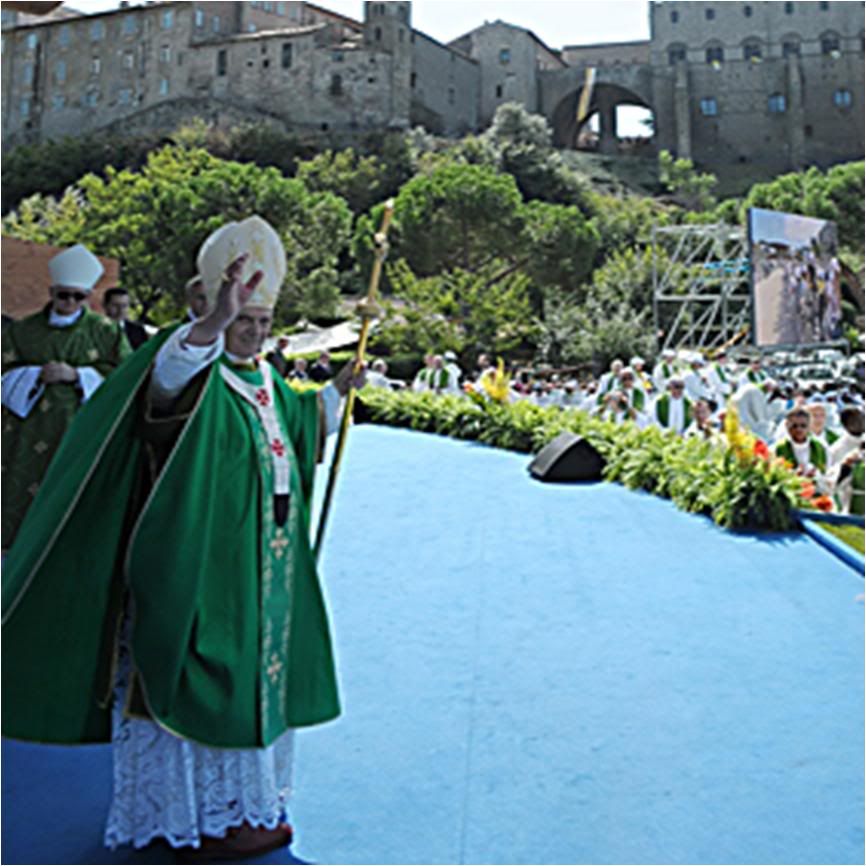 The Mass at Valle Faul.
The composure of a concrete
The Mass at Valle Faul.
The composure of a concrete
manifestation of affection
by Mario Ponzi
Translated from

Between present and future. From his citation of Dante's lines in the Divine Comedy, referring to St. Bonaventure "who in discharge of my great offices still laid aside all sinister aim" - meaning temporal realities over the spiritual - to his exhortation to Christians to bear witness to their faith 'without fear' through social commitment and politcal activity for integral human development and to give 'wings to hope'.
Perhaps this contrast between the past and that which is yet to come was never better synthesized than in Benedict XVI's visit to Viterbo adn Bagnoregio.
Yet yesterday, Sunday, Sept, 6, while the
vetus urbis, old city, which is the etymology for Viterbo, opened up its past which is eminently pontifical, to a Pope who came as a pilgrim to its ancient dioceses, the new Viterbo, which is seeking its place in the society of the digital era, also showed him the apprehensive face of new generations facing an uncertain future.
Likewise, the signs of hasty progrss which has not yet allowed a reciprocal acceptance between the old city and the new. The two faces of a city which came together to give Benedict XVI the memory of a day among its celebratory but composed citizenry.
Because it was a celebration from the first moments of the visit.
Welcoming the Pope, who arrived by helicopter at 9:30 at the Rocchi sports field, were the Bishop of Viterbo, Mons. Lorenzo Chiarinelli; the Apostolic Nuncio in Italy, Mons. Giuseppe Bertello; the underesecretary of the Prime Minister's cabinet, Gianni Letta; the Italian ambassador to the Holy See, Antonio Zanardi Landi; the president of Lazio region, Piero Marrazzo; the president of Lazio province, Alessandro Mazzoli; and the mayor if Viterbo, Giulio Marini.
An informal welcome, and then a fast drive to the center of the city in Piazza San Lorenzo. The motorcade passed through the narrow streets of the historical center, between medieval edifices which seemed to rest on the masses of people along the streets.
Between these crowds, the motorcade arrived at the Palazzo dei Papi, the first stop of the program. The Pope greeted the city from the historic loggia of the 12th century palace.
Welcome speeches by the bishop and the mayor, an exchange of gifts, and then, the blessing of the new bronze doors of the adjoining Cathedral of San Lorenzo, which will remain as a lasting memento of a day of faith spent with the Pope.
He did not fail to enter what had once been the papal residence - it had been 25 years since a Pope had been here, John Paul II who visited Viterbo in 1984.
Benedict XVI visited the famous Conclave Hall, where, in the 13th century, the Conclave was born - election of a Pope with the cardinals under lock and key - as it has since come down to our day.
The Pope's brief tour evoked a constellation of memories linked to the passage through Viterbo of great saints - Rosa, Crispino, Giacinta, as well as eminent Popes, cardinals and laymen like Mario Fani, pioneer of the modern lay apostolate and co-founder of Italian Catholic Action, who was inspired by the city and his devotion to its patron Santa Rosa.
Then, another passage through the crowds to proceed to Valle Faul where he celebrated Mass. Almost 30,000 people found space in the ample esplanade even if only 15,000 seats were set up.
Here Viterbo showed its new face to the Pope, with so many young people in the congregation in front of the altar, as well as in the hills overlooking Valle Faul.
There were no streamers nor the usual sea of flaglets. Viterbo's famous historical cortege stopped short of the esplanade, deployed along its medieval streets.
Subdued applause greeted the Pope as he passed through the crowd in the Popemobile - according to the diocesan instructions that for the Mass, 'temporal realities' should give way to the spiritual.
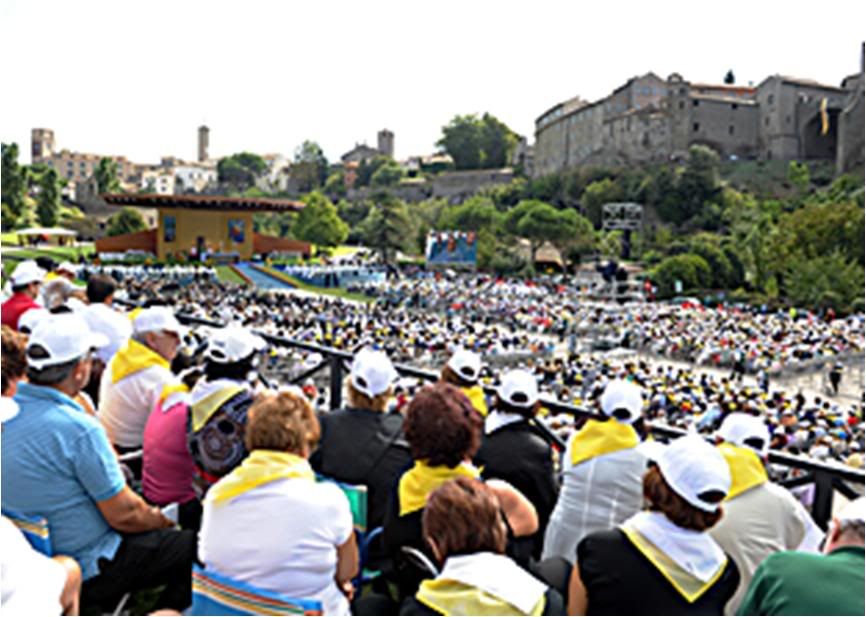
The Pope concelebrated mass with Cardinal Agostino Vallini, his Vicar in Rome, and the other bishops of Lazio; Mons. Charinelli; Archbishop Fernando Filoni, undersecretary of state for foreign relations and scholar of Viterban history, having studied at the seminary of the Madonna della Quercia; Archbishop James Harvey, prefect of the Pontifical Household; Mons. Paolo De Nicola, Harvey's deputy; Mons. Georg Gaenswein, the Pope's private secretary; and Mons. Fortunato Frezza, undersecretary of the Bishops' Synod. Along with dozens of diocesan priests, including functionaries from the Roman Curia who come from Viterbo and Tuscia.
The Mass offerings came from representatives of the four ancient dioceses that were consolidated with Viterbo in 1986 - Acquapendente, bagnoregio, Montefiascone and Tuscania, with a cross-section of Viterbans, among them, two 'facchini di Santa Rosa' and two 'ciuffi' - representing the 140 persons (facchini) who carry the towering 'macchina di Santa Rosa' on its annual transport through old Viterbo (the 'ciuffi' are the key facchini who insure the equilibrium of the tower during the transport).
In place of the Pope, Cardinal Vallini distributed Communion. because, the Pope's personal physicain, Dr. Patrizio Polisca explained, the Pope wrist is still healing, and it was not advisable for him at this point to perform the repeated motion of drawing the host from the ciborium and placing it on the tongue of the communicant.
Polisca added that rehabilitation therapy to recocver full functionality of the wrist has begun but will take a few weeks.
"The act of taking the consecrated hope from the ciborium and offering it to the communicant is a gesture that requires full functionality to make sure the Host does not fall," he also explained.
After leading the Angelus with the congregation, the Pope left Viterbo for the Shrine of the Madonna della Quercia on its outskirts, where he lunched with the bishops of Lazio.
After a brief rest, he met with the cloistered nuns of the diocese and prayed with them in front of the miraculous image of the Madonna, declared patron saint of the consolidated diocese when John Paul I created it in 1986.
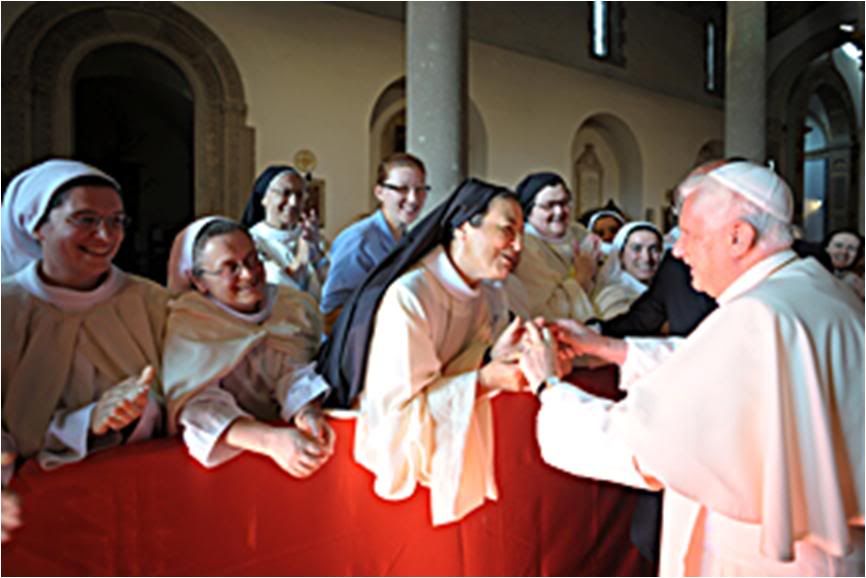 With regular nuns at the Basilica of the Madonna della Quercia.
With regular nuns at the Basilica of the Madonna della Quercia.
The coming days will tell what the few hours spent in Viterbo by the Pope will mean for the diocese.
The impression gathered from those who left the Mass was that of a diocesan Church which wished to show the Pope a people firmly rooted in human and Christian values, who look to the future while jealously guarding their traditions.
The Pope came at a particular time in the pastoral life of the diocese in order to confirm all Catholics in their faith, as the visit motto says, but also to provide a moment of reflection on the great crises of our time in order to be very clear about the values the faithful need in order to go forward.
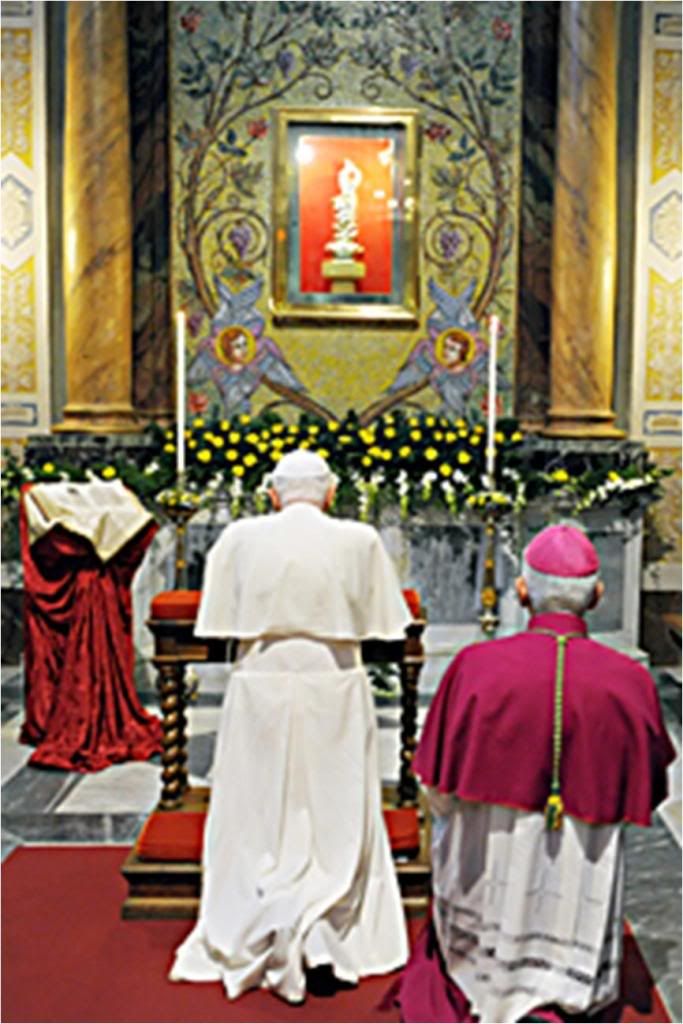 At the Co-Cathedral of San Nicola in Bagnoregio.
The Pope's afternoon
At the Co-Cathedral of San Nicola in Bagnoregio.
The Pope's afternoon
in Bonaventure's hometown
with a people who live on history
by Mario Ponzi
Translated from

A faith that is a friend to intelligence in order to restore wings to hope. This was the message that Benedict XVI left the faithful of Bagnoregio at the end of a day spent among the people of Upper Lazio, as they face the future.
The Pope spoke this time in the birthplace of St. Bonaventure, to a community that inhabits a jewelbox of history and art, culture and traditions, epitomized by the ancient city where time seems to have stopped, on the rock that dominates the territory.
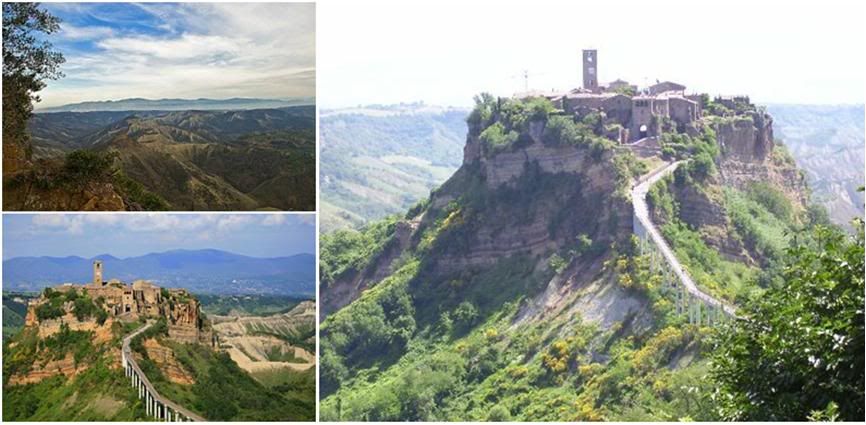 Civita di Bagnoregio: online stock photos, not provided by OR.
Civita di Bagnoregio: online stock photos, not provided by OR.
The Civita di Bagnoregio, cultural patrimony of humanity, a unique marvel sui generis, is now called 'the dying city', because the tufaceous outcropping over clay on which it was built is eroding very slowly but inexorably. Unstable terrain, and by its very nature, exposed to the erosive action on the tufaceous rock and clay leaves 'peaks' among the furrows called 'calanchi'.
Over the past few centuries, the people gradually filtered out from the old 'city on the hill' to the stable plain below, in the city also called Bagnoregio, bearing the collective memory of the Civita.
It is almost superfluous to dwell on the enthusiasm with which the citizens of this medieval burgh welcomed the Pope. For them it was an exceptional occasion that was celebrated with great joy.
Mayor Biagiotti, greeting the Pope, recalled that despite the impressive historical links of the region to the Popes, none of the 50 Popes who visited Viterbo had ever been to Bagnoregio, although Pius IX passed through on a visit to northern Lazio.
The passage of the Popemobile through the narrow streets of the town, with Vatican flags and images of St. Bonaventure hanging from windows and balconies along the route, was very emotional. Welcome signs were everywhere, some even written in Latin.
After a brief visit to the Co-Cathedral of San Nicola to venerate the relic of St. Bonaventure (the 'Holy Arm') and to admire the so-called St. Bonaventure Bible dating to the second half of the 13th century, the Pope emerged to Piazza San'Agostino, where a stage had been set up in front of the monument to St. Bonaventure, for the Pope's encounter with the townspeople.
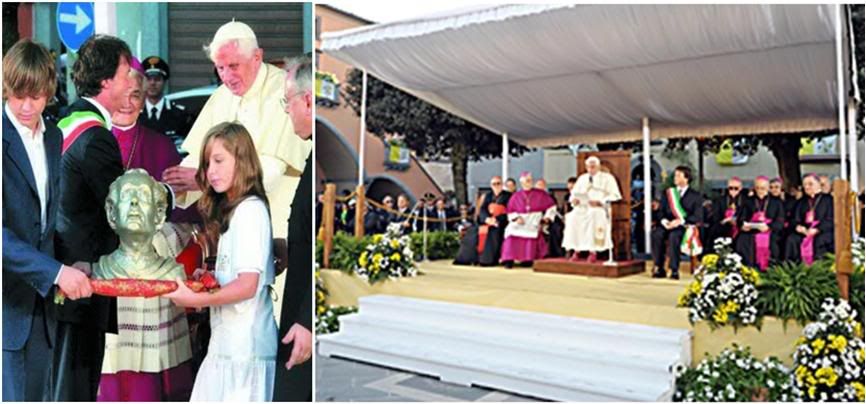 Left, The mayor of Bagnoregio presented the commune's gift to the Holy Father - a commissioned sculpture of St. Bonaventure. Right, the Pope addresses the townsfolk.
Left, The mayor of Bagnoregio presented the commune's gift to the Holy Father - a commissioned sculpture of St. Bonaventure. Right, the Pope addresses the townsfolk.
"(This is) a community that is very much alive," said Mayor Biagotti in formally welcoming the Pope, "which is aware of being immersed in a current of life that comes to us from remote times, and carrying in itself the history, the culture, the tradition of hard work, and the spiritual moral and civic qualities deriving from such legacy".
Our people are gentle, Bigiotti said, and "like the
calanchi that surround us in the east, they mark the passage of time by showing to all their wounded yielding sides" while at the same time, they are "tenacious like the underlying basalt whose reassuring solidity we have felt through the centuries".
"And what will Bagnoregio be in the future?" he asked. In answer, he quoted from the city's illustrious saint, "If life is a journey, it means that we must orient all our steps towards a tomorrow that we must begin to construct today".
In his own address, Benedict XVI picked up on the mayor's question: "Indeed, we all ask ourselves abour our future and that of the world, a question that has everything to do with hope."
But it must be a 'reliable hope', which can give us "the certainty of reaching a great goal that justifies the effort of the journey", as he wrote in the encyclical
Spe salvi: "Only this great hope-certainty assures us that, notwithstanding the failures of personal life and the contradictions of history in general, the indestructible power of love will always protect us."
St. Bonaventure's example should therefore serve to help us today 'open wide the wings of hope" and be, like him, "searchers of God, singers of the beauty of creation, and witnesses to that love and beauty which 'make everything move'".
A brief greeting to the authorities present, some moments spent with the sick and disabled, and the Pope then left for the improvised heliport to fly back to Castel Gandolfo.
 I must say I am not a fan of the Italian style of news reporting which I find too impressionistic, rather superficial, and often not exhaustive. It is an odd mix of objective fact and random flights of fancy prose, instead of the straightforward reporting of an event, spiced by local color and detail where necessary, that I learned in American-style journalism.
I must say I am not a fan of the Italian style of news reporting which I find too impressionistic, rather superficial, and often not exhaustive. It is an odd mix of objective fact and random flights of fancy prose, instead of the straightforward reporting of an event, spiced by local color and detail where necessary, that I learned in American-style journalism.
The Italian style is an awkward mix, and is even more awkward in the hands of the OR reporters, whose only advantage is that they sometimes have details that are not reported elsewhere - though not too many in the case of the Viterbo-Bagnoregio visit.
Also - even if it's a colossal bore and almost a waste of time to translate OR stories (it takes time and great effort to shape their reports into a reasonably readable news story while trying to be as faithful as possible to the language and construction used, so how I welcome it when the story is an interview instead!) - it's good to go on record with how the Pope's newspaper reports on the Pope, so 'gladly the cross I bear'!
Of course, most of the time, it is done without an accompanying story, merely the full papal text from an event in both the original language or languages it is delivered, as well as its Italian translation. That is the greatest service that OR does. The translations of these texts in the Vatican's official languages subsequently appear in the following weekly OR published in English, French, German, Spanish, and Portuguese, and once a month, in Polish.
There are, of course, the occasional editorials about the Pope and his messages and actions, but the news reports as such only come when he makes these pastoral visits or apostolic trips abroad, brief reports when he is on vacation, and exceptional stories as when he fractured his wrist.
What the OR needs is someone like Dino Boffo (without his baggage), a genuine and talented journalist who made Avvenire into the admirable newspaper it is today). And that expresses all my disappointment after almost two years in Giovanni Maria Vian, an academic who has really tailored his brand of journalism to the exigencies of the Secretariat of State.
BTW, the only reason I have not been able to use Avvenire as often as I want to is that since it changed its online viewing platform to an elaborate PPF set-up, it has not always been technically accessible, and if I cannot access it the first time I try to do so during the day, I often do not have the time to go back to it later. It's a pity because they often have very good graphics that are worth using to illustrate current reports about the Church (or secular news, for that matter).
[Modificato da TERESA BENEDETTA 08/09/2009 15:06]